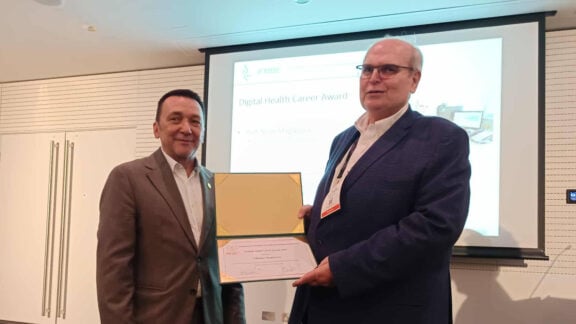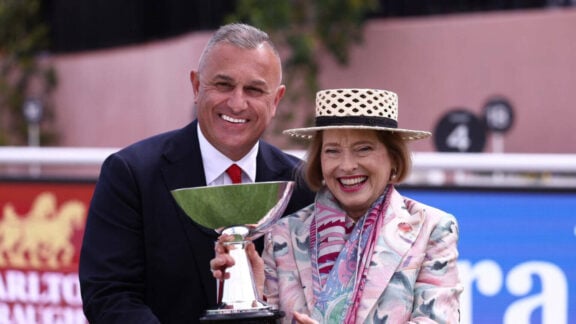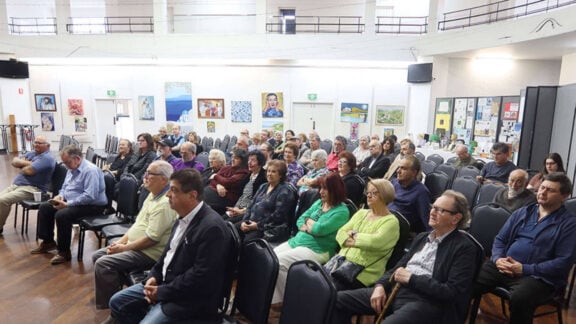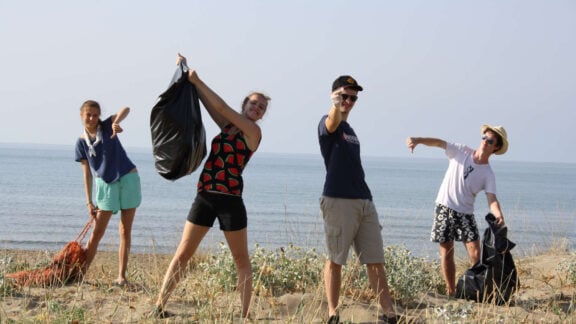It was my pleasure to have delivered this year’s annual Alex Kondos Memorial Lecture at Brisbane’s Greek Club. The lecture is held each year by the Greek Orthodox Community of St George Brisbane to honour the memory of Dr. Alex Kondos a Councillor of the Community. This year the Solomos Society Greek Australian Cultural Association of Brisbane co-hosted the event. Master of Ceremonies for the evening was Secretary of the Community’s Cultural Committee Tom Drakopoulos.
The Greek community in Brisbane is a thriving one. There are an estimated 25,000 Hellenic-heritage residents in South-East Queensland. Many of these are the descendants of Hellenes who came to Australia before the Second World War. Tom is an example of these, his heritage drawn from the Island of Ithaki in the Ionian Islands. He told me how he is currently planning a trip to Ithaki, his first trip there in 40 years. He joked that it had taken him much longer than Odysseus to return to Ithaki!

For those who have yet to visit the Greek Club, it is an impressive building overlooking Musgrave Park. A large two-storey complex, the modern structure includes a large auditorium with all modern features, ample parking and a lovely Greek restaurant and bar, offering innovative Greek cuisine and a great selection of Greek wines. During lunch I enjoyed a glass of crisp, aromatic white wine from Argos’ Skouras winery on the recommendation of wine distributor Jimmy Bazianas.

I made my presentation before a packed audience in the auditorium, preceded by the young members of the Hellenic Dancers group who performed a trio of dances from the northern Aegean. My presentation covered the role of Lemnos in the Gallipoli campaign of 1915-16, with reference to the part played by the nearby Islands of Imbros and Tenedos. I outlined Lemnos’ transformation into the Advanced Base of the campaign, the location of hundreds of Allied military shipping in its great harbour of Mudros Bay, the creation of the infrastructure of a major military camp (such as new piers, roads, railways, navigational beacons and buildings), the establishment of rest camps, medical facilities, engineering works, ship repair facilities and supply depots.

I explained how the Base brought nearly all of the 50,000 Australian service personnel who served at Gallipoli to Lemnos for greater or lesser periods of time, as did the tens of thousands of British and French Empire troops, as well as the Hellenes who supported the Allies including those who fought alongside the Allied troops on the Peninsula in the French service.
Most importantly I explained the interaction of these young Australians with the local Islanders, of how these two communities – Australian and Greek – came together for the period of the campaign, as the Islanders offered their hospitality to the Australians and as the Australians wandered and relaxed on Lemnos.

I explained all this by referencing the Queensland connection to this Lemnos-Anzac story – from Brisbane-born Matron Grace Wilson to the medical officers Major John Gibson, Major Herbert Stewart and Captain John Hardie, as well as the many other nurses and soldiers who served on Lemnos and wrote about their experiences on the Island. Townsville’s Private James Donaldson wrote of his camp on the shores of Mudros Bay as “a beautiful spot”. It was Queensland soldiers who helped in the building of the new stone pier at Mudros that would be known as the Australian Pier, one of those being Brisbane teacher Corporal George Richards who wrote home that the Lemnians could be proud of their work on the pier, which is still in use today. It was Matron Wilson who wrote of the poor initial conditions at the field hospitals on Lemnos as being “two awful for words”, reflecting the view of many. It was Major Herbert Stewart who praised the service of the nurses there. And some of those buried on Lemnos would be from Queensland, including Brisbane’s Private Alexander Jones and Private Lloyd Allison from Cunnamulla.

I also talked of Imbros and Tenedos, the overwhelmingly Greek populated nearby Islands, who also played key ancillary roles in the Gallipoli campaign. Imbros was the Allied base closest to the fronts at Anzac Cove and Suvla, the site of the Allied Headquarters on the shores of Kephalos Bay, whose waters acted as a roadstead for the Allied vessels bringing troops and supplies to and from the fronts. The location of the Australian Bakeries supplying fresh bread to the troops at Gallipoli, Imbros was also home to medical facilities, rest camps and a major Allied air base. Tenedos was an Allied naval and air base. Like Lemnos, both Islands witnessed the interaction of Allied soldiers and other personnel with the local Hellenic population.
I spoke of how the post-WW2 migration from Greece has resulted in instances of Greek Australians combining both Lemnian and Anzac heritage. This is the story of Melbourne’s Lee Tarlamis OAM MP, whose father hailed from the Lemnian village of Nea Koutali while his mother is the descendant of Private Ted Tozer, a digger from Melbourne who served on Lemnos. I have speculated that Ted – like many other Anzacs at the time – most probably walked the land where Nea Koutali was established.

This story resonated with more than a few of the attendees with connections to Lemnos and Imbros. One of the former was Leonidas Naoumis, a community activist and 3ZZZ radio broadcaster. His heritage also stretched back to the village of Nea Koutali on Lemnos, a village established by Asia Minor refugees who arrived there from the Island of Koutali following the Asia Minor catastrophe. It was also a pleasure to meet the family of Alex Kondos during the presentation. My presentation resonated with his daughter Marea who brought along a package of archival photographs collected by Alex depicting Australian troops in Athens in 1941.
Another I had the pleasure to meet was Brisbane medical doctor and author, Tina Bazianas. I have been communicating with Tina for a number of years, discussing her literary project, a historical novel based around the story of the Anzacs in Kalamata during the Greek campaign of 1941. I have been impressed by Tina’s literary effort and Tina’s commitment to anchor her fiction in historical reality. Her new novel has been drafted and will hopefully be published in the near future. I know that many in Melbourne’s Pammessinian community are keen to hear from Tina and wish her success in her publishing venture. I hope to welcome her to Melbourne to promote her work.
The Greek Club is located in Brisbane’s west end area, a home to migrants for many decades including those from Greece and Cyprus. Evidence of the once dominant Hellenic community remains in the many community institutions located there – The Church of St George, community aged care and childcare services, AHEPA, the Cypriot community as well as the many Greek restaurants and other businesses. I was honoured to enjoy the hospitality of Petros Permaklis of the Kafenio restaurant. A native of Florina, with Pontian roots back to Trapezounta on the Black Sea, he served amazing lamb, washed down with Cypriot Leon beer and a glass of tsipouro!
It was a pity that I had to return to Melbourne a few days before this year’s Paniyiri Greek Community Festival which takes place in May each year in Musgrave Park. The Festival occupies much of this large park and encompasses community stalls, Greek food, music and dancing. This year will see presentations on Maria Callas and Nana Mouskouri. A pop-up Greek village has also been created for the event.

My discussions with the Greek community included the possibility of bringing the new Imbros & Gallipoli Exhibition to Brisbane as well as the forthcoming Anzacs The Greek Chapter documentary film being completed by Dr Peter Ewer and filmmaker John Irwin, assisted by myself and Ms Vicki Kyritsis, on behalf of the Lemnos Gallipoli Commemorative Committee. The former could be displayed in the lead up to Anzac Day 2024 and the latter shown as part of the annual Greek film festival organised by the community in Brisbane. Jimmy Bazianas explained the long and interesting history of Greek cinema proprietors in Queensland, including Peter Sourris who took an innovative portable cinema to the outback.
Jim Claven is a trained historian, published author and freelance writer. He thanks the Greek Orthodox Community of St George for the invitation to deliver the Alex Kondos Lecture, also sponsored by Brisbane’s Solomos Society. He thanks Tom Drakopoulos, Tina & Jim Bazianis, Petros Permaklis and Leonidas Naoumis for their hospitality and warm introduction to Brisbane’s Greek quarter. Jim can be contacted via email – jimclaven@yahoo.com.au








